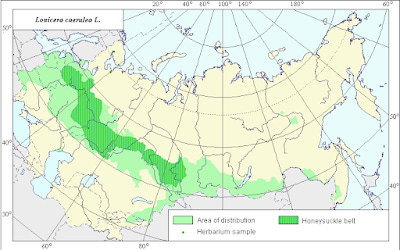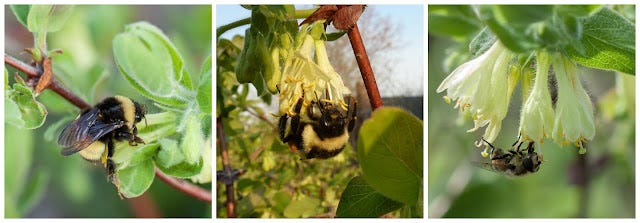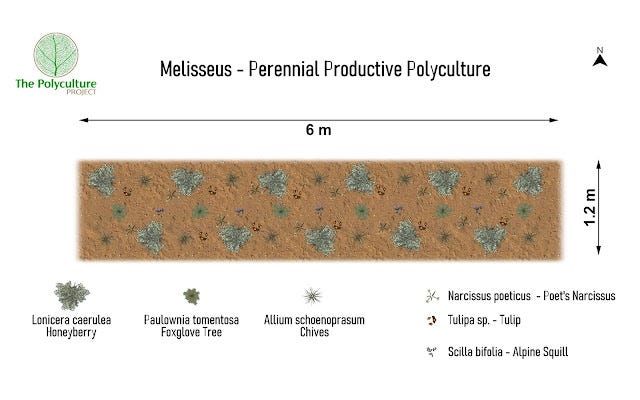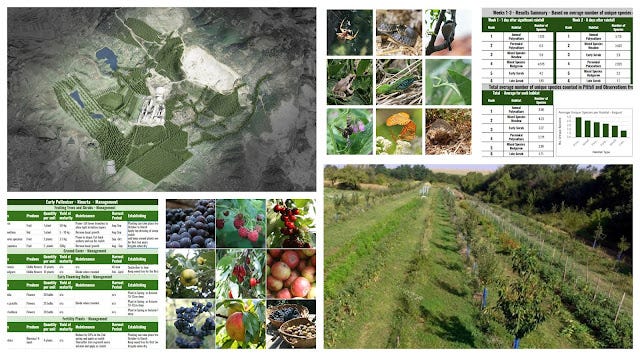Honeyberry - The Essential Guide to probably everything you need to know about growing Honeyberry - Lonicera caerulea
Honeyberry, also known as Blue Honeysuckle, or Haskap is a small perennial shrub with delicious edible berries. The great news for people that live in the colder parts of our planet is, unlike most delicious fruits, Honeyberry grows best in cold climes. More good news, if you love blueberries but don't have acid soils, Honeyberries make a great substitute, if not better, and can be grown on acidic, neutral, or alkaline soils. The plants are easy to grow and largely untroubled by pests and diseases making them ideal candidates for permaculture and forest garden growers. Being small and compact they are suitable for all-sized gardens and even grow well in containers so great for patio/balcony gardeners too. During this post we'll take a detailed look at Honeyberries, including their history, how to grow them, the uses of Honeyberry, growing Honeyberry in Polycultures, Permaculture, and Agroforestry, and we'll end the post by introducing some excellent cultivars that we're offering from the nursery this season.
Overview
Honeyberry belong to Caprifoliaceae, a large family of about 860 species represented by 42 genera one of which is Lonicera, itself a rather large genus including 180 species of shrubs, vines, and herbaceous plants. Many species in the Lonicera genus (commonly known as Honeysuckle) are well known for their attractive flowers and are popular in gardens and landscaping but there are also a number of species found growing in the cool regions of the Northern hemisphere, with edible fruits. These are the Honeyberries.
Compared to the other cultivated fruits we have profiled on our blog, Honeyberry is a relative "newb" with just over half a century of breeding selection, mainly in North Japan, Russia, and more recently Canada and America. (see history below) Nevertheless, there is a surprisingly large selection of cultivars to choose from.
There is a considerable amount of taxonomic confusion and debate and depending on which botanist or breeder you talk to, there are up to 17 species with edible, sweet-tasting fruits and many more species with edible but bitter fruits. One botanist put it like this "Honeyberry is a polymorphic, species, with several ecogeographic forms, designated subspecies, or sometimes, separate species." It is from this wild larder that plant breeders around the world have been busy producing plants that yield great-tasting fruits, and are well-suited for broader cultivation.
For the rest of this post, we will focus on Lonicera caerulea, a significant parent plant of the majority of Honeyberry cultivars.
Honeyberry - Lonicera caerulea
Latin name - Lonicera caerulea
Common name - Honeyberry, Haksap Berries, Blue Honeysuckle, Haskap
Family - Caprifoliaceae
History - The history of honeyberry cultivation is not well documented, but one would assume it has been eaten by people that lived in its native growing range for more or less as long as the plants and people have been there. The indigenous Ainu of Hokkaido (Japan) has known and used the plant for centuries. Another common name for Lonicera caerulea, Haskap, is a derivative of the Ainu name for the plant "Haskappu".

In the 1970s, selective breeding began in Japan. In Russia, the plant is mentioned in a text by S. Krasheninnikov as late back as 1756 but not until 50 years ago, did breeders from the U.S.S.R start selecting and introducing new varieties making Russian cultivars some of the oldest and most well-researched. Following the collapse of the U.S.S.R in 1986, the movement of people and information became more open between the East and West, and many Russian-bred honeyberry cultivars made their way to Canada where breeding started, with the first four cultivars being registered in 1997. Today breeding continues all over the world including in the US, New Zealand, and Europe.
Growing range - Not many tasty fruits can make the claim of being circumpolar and unlike the majority of fruits, it's the colder regions of the world where growers have the advantage. The plant grows wild in and around boreal forests in moist rich soils, in northern temperate climates including Asia, Europe and North America. The below map from the AgroAtlas Project shows the native growing range of Lonicera caerulea in its native territory in Asia.
Honeyberry grow best in the latitudinal range of the 42nd to 62nd parallels north and presumably south of the equator (although few records of this plant growing in the southern hemisphere are available). There does not appear to be any data on the commercial growth of Honeyberry. Russia, Japan, China, and Canada probably produce the highest quantity and you can find many growers in the USA, and Europe. The below image maps the areas of commercial orchards in the Northern Hemisphere, circumpolar area. Regarding the Southern hemisphere, I found some records of trials underway in New Zealand.
Description - The plants are medium-sized deciduous shrubs growing between 1.5 - 2.5 high and 1.5 - 2m wide. The leaves are simple, opposite, oval to elongate, and 3–5 cm in length. The small cream-colored, tubular flowers appear in very early spring followed by purple fruits very early in the summer,
In late May - early June, assuming pollination and fertilization have occurred cylindrical blueberries will form that has a sweet, tangy, very aromatic taste when ripe. The fruit shape ranges from oval to long and thin, depending on the cultivar, with individual fruit weight ranging from 0.3 g to rarely over 2.0 g. There is a maximum of 20, but usually fewer, very small seeds in a fruit. Flowers are small, about 2 cm long, tubular with flared lobes. Each flower consists of two tubular corollas atop what appears to be a single ovary, but that actually consists of two ovaries surrounded by fleshy bracts. The fruit is actually a fleshy growth that surrounds the two ovaries
The root pattern is branching: a heart root, dividing from the crown into several primary roots going down and out. The majority of feeding roots will develop near the surface and should consider the plant shallow rooting.
Life Span - The productive life span of the plants is around 30 years, I'm not sure how old they can live, reports range from 30 - 50 years
Habit - The plants are densely multistemmed, and the growth rate is considered medium (30 cm to 60 cm of growth per year). Although they do not sucker, branches making contact with a moist soil surface are likely to develop roots thought-out the growing season.
Sexual Reproduction - The plants are essentially self-incompatible and require bees for cross-pollination. Planting in pairs or groups is essential for fruit production. If the flowers are successfully pollinated and fertilized, the berries will begin to form and will ripen. Contrary to what may seem obvious this may take from 80 to 90 days in warmer areas and 50 to 60 days in colder areas. Due to the early blooming in spring when temperatures are often unfavorable for honey bees, bumble bees are considered the principal pollinators.

Light Preferences - The plants grow best in a sunny position with 6-8 hrs of direct sunlight per day but can grow well in partial shade with 4-6 hrs but will not fruit so well.
Water needs - Being accustomed to growing in cooler climates the plants prefer moist soils throughout the growing season. They are surprisingly drought tolerant but we have found the plants we grow that are not provided with irrigation throughout the year will grow at a much slower rate and produce far less fruit.
Biodiversity - A highly rewarding bee forage plant with attractive nectar. Preferenced by long-tongued bees, especially bumblebees. As the plants develop the dense shrub form should provide suitable refuge for a range of ground-dwelling invertebrates and small mammals.

Hardiness - The plants are hardy to USDA 2 tolerating winter lows of -40 C. One of the warmest places in the world where Lonicera caerulea can be found in abundance in the wild is south/central Hokkaido, Japan which is USDA hardiness zone 5a. The development of new cultivars using germplasm from these wild plants makes it possible to now grow the plant in warmer regions further south of its natural growing range but it's unlikely to grow well above USDA hardiness zone 7.
Where to Plant
Climatic Limitations - Being a northern-adapted crop species they will not grow in tropical, subtropical, or Mediterranean climates although there is a push to develop cultivars that grow further south. Here's a quote from Dr. Bob Bors, Head of the Fruit Breeding Program at the University of Saskatchewan.
"Assuming good care and reasonable soil conditions, I’d guess that zones 1 to 4 will be able to grow virtually any type of haskap. Zones 5 and 6 might get away with some hybrids but it would be best toplant more late-blooming types. Zones 7 and warmer should restrict themselves to ‘late blooming Japanese types’ until some breeding breakthroughs are made. As Haskap is a new crop it is highly recommended to do trials of smaller numbers before planting large numbers of plants forcommercial production. Try several varieties to see what is best in your location. It may take a year or three to determine if any particular haskap variety is adapted to your region and blooms at the right time of the year." You can find the full text regarding his view on how far south Honeyberry can be grown here.
Soil - Honyberry will grow in most soil types including clay and are more tolerant of wet soils than most fruit species but will not tolerate long periods of waterlogged soils. They can survive in a wide range of pH 3.9 -7.7 but they will grow best and produce the highest yields in fertile moist soils with pH 5.5 -6.5. It's probably best to avoid heavy clay that retains water after rainy weather and fast-draining, sandy soil that dries very quicky.
Pollination/Fertilisation - Honeyberry is non-self-fertile with cross-pollination essential for fruit bearing. Two cultivars that flower during the same period are necessary. These partners should be within 15m of each other although planting 4 or 5 different cultivars together in a patch will probably deliver the best results. If you do choose to plant the shrubs together then spacing them 1m - 1.5 m apart is recommended. Although wind pollination can occur, bees, especially bumblebees are the preferred pollinating agents so having plenty of habitats for bumblebees to nest and forage year around is a great idea.
Location - As mentioned above it's important for Honeyberry to be grown with pollination partners.
A place with plenty of Sun and good fertile soil is best if you want healthy plants and plenty of fruit. Good air circulation will help prevent disease and promote better photosynthesis so don't crowd the plants in. 2.25m2 is enough space for the plant to grow unhindered. Honeyberry will take root from stems touching the ground (layering) easily so if you wish to spread them into a larger area via layering consider this when you space the plants.
It's best to avoid planting against south-facing walls as these are generally hot and dry during the summer two things Honeyberry does not appreciate. In fact, planting next to any wall is not recommended as the shallow roots of the plants will be restricted.
Feeding, Irrigation, and Care
Planting - Planting out when the plants are dormant and leafless will avoid leaf burn that known to be an issue when planting out actively growing potted plants in the spring and summer.
Feeding - The plants will benefit from an annual top dressing of 20 L of your finest compost just before the growing season starts. This should provide them with enough fertility for the entire growing season.
Irrigation - Honeyberry can tolerate drought conditions, however, like the majority of plants, honeyberry will grow best and produce the most fruit when it receives adequate moisture. Approx 30L of water applied to young trees every week without rain will be adequate and mulching will help reduce the frequency of watering. If you are growing honeyberry plants in containers, they will likely need to be watered more frequently than plants grown in the ground. Keep an eye on the soil moisture level and water the plants as needed to keep the soil evenly moist (like a wrung-out sponge).
Weeding - Mulching plants with a 10 -20 cm deep layer each spring, and pulling weeds that start to grow through in the summer is good practice when the plants are young. As the plants mature, the dense branching will likely shade out directly beneath their crown, and they will grow well among other plants as long as they are still receiving enough light, water, and nutrients.
Propagation - An easy way to propagate Honeyberry is via stooling, the official term for piling soil up about 25 cm high around the base of the shrub in the springtime. The following Spring, pull back the soil or use the garden hose to wash the soil away from the base and cut away all of the branches where roots have formed. Plant these rooted branches individually in 10L pots for another season before planting out in the garden. Layering will also work (the same method but with individual branches).

Dormant cuttings are also a good way to propagate Honeyberry and they can root in water, in the ground, or in a seedling mix in pots.
Pruning - For the first 5 years, the only pruning needed is to remove any dead or dying parts of branches. After the fifth year, thinning may be required to keep the bushes open. This can be achieved by cutting to ground level weak, old stems that no longer produce strong young wood. As a guide, aim for four to six of the vigorous older stems and one to two strong new shoots. Avoid cutting the tips of the branches as this is where the majority of fruit will be produced.
Harvesting - The fruits will start to ripen from the end of May - early June. It can be difficult to gauge when they are ripe as the berries may turn blue and look ripe a few weeks before they are ready to harvest. Some cultivars will turn dark purple inside when they are fully ripe. One good way to tell if they are ripe is, the ripe fruit will come loose and fall to the ground if the plant is carefully shaken. If you have space around the plant "Cutaways" will work well as shown in the below image.
Mature berries can hang on the bush for up to a month before going overripe so harvesting later rather than earlier is fine. It's easy to pick the fruits individually by hand or use a hand berry harvester.
Welcome to our Online Store where you can find Forest Garden/ Permaculture plants, seeds, bulbs, and Polyculture multi-packs along with digital goods and services such as Online Courses, Webinars and eBooks. We hope you enjoy the store and find something you like. It's your purchases that keep our Project going.
You can also find our full list of trees. shrubs and herbs for forest gardens on our nursery website.
Potential Problems
Problems
In otherwise suitably cold climates, intermittent warm periods during the Autumn may cause a delay in the process of preparation for winter dormancy of the plants and secondary flowering of the plants may be observed. We've never experienced this with our plants so this could be a case of bad cultivar selection.
The plant flowers early in the season and have no trouble with late frosts, open flowers will survive -7⁰C. However, there could be a problem with pollination if your plants are flowering in weather too cold for the bees to be active. Hand pollination is possible in such cases
The main problem we have had with these plants in our garden on the 42nd parallel north in hardiness zone 6a (on the edge of their preferred growing range) is leaf burn during the hot summers.
They look pretty bad during high summer but the fruits ripen in late May - Early June well before the onslaught of summer and seem to recover well by the spring. Nevertheless, I'm sure they would be much larger by now and feel better without the leaf burn so we're going to experiment with growing a patch of Honeyberry with Paulownia tomentosa - Foxglove Tree saplings within the beds to see if the controlled shade during the high summer helps with the leaf burn. (see Honeyberry shade Polyculture below) We've used this setup for sun-sensitive vegetables in the past and it worked out well, we'll see how it goes.

Pests and Disease - Powdery mildew has been known to affect honeyberries and good general plant care will certainly help avoid problems. There are no records of significant pest issues, this may change as more monoculture orchard plantings are likely to be established. It's also good to know that deer tend to avoid Honeyberry.
If you live in an area where birds are commonly known to eat soft fruits, it is likely that birds will eat Honeyberry too. In such cases, bird nets are the most effective way to keep your crops safe.
Uses
Fruit - Honeyberry flavor is unique and depending on the cultivar can vary considerably; from, sweet and tart to slightly bitter with the modern cultivars on the sweet and tart end of the spectrum. The berries are best eaten fresh and have a short shelf life, hence you are unlikely to find these delicious berries in the supermarket although they do freeze well. They are very rich in Vitamins C, A and anti-oxidants. Vitamin C and vitamin A content compare very favorably against most other common fruits.
The fruits can be used to make jams, preserves, juices, syrups, tarts, cakes, pies, liqueurs, and wines. You can find a super simple Honeyberry jam recipe at the end of this post.
Yields - Providing you are growing a number of compatible cultivars (for cross-pollination), you can expect fruits in the 3-4 years of the plant's life and the plants will reach peak production in the 5th - 7th year. Harvest will vary from 1.3 - 3.5 kg per shrub at maturity, depending on cultivar choice and whether ideal growing conditions are provided.
Hedging - The plants can make an effective low-growing hedge and can be layered to spread in the desired direction you wish the hedge to stretch. I'm not sure how well they take to trimming but given that the majority of plants in this genus are extremely tolerant of trimming I expect they should respond well and a dense hedge should be possible to achieve with annual or biennial trimming once the plants are established. Bear in mind that pruning will drastically reduce the fruiting potential as fruits are formed on new growth.
Medicinal uses - Honeyberry has a long history of medicinal use in Japan where they were attributed with high nutritional and medicinal value, a fact supported by recent phytochemical analyses. I did find quite a lot of claims including postponing aging, improving brain functions, and preventing obesity. A lot of these claims were from marketing material that appears to be trying very hard to get Honeyberries on the shelves of supermarkets all over the world. Nevertheless, they are obviously healthy fruits :)
Polycultures and Permaculture
So far we have been dotting our honeyberries around the forest garden, along the edges of our irrigation channels and in gaps between fruit trees to provide them with adequate light. We've been stepping up our propagation of these plants and have gathered what we hope to be some great performing cultivars for our climate (see below) and plan to introduce a few polycultures that feature honeyberry in our new Forest garden. One such design is what we call Melisseus (the Greek demi-god of Honey)
Melisseus - Honeyberry Polyculture - The primary goal of this polyculture is to produce a reliable crop of Honeyberries, a source of mother plants to further expand our berry production and planting stock for the nursery. We've found our current Honeyberry plants suffer from leaf burn in high summer so we have included Paulownia tomentosa - Foxglove Tree saplings in the center of the bed to provide some shade for the plants. Paulownia responds very well to fast coppicing and can be cut back each Spring before leafing out and will grow approx 2m high by the end of the summer. The Paulownia will be serving as shade during high summer and will provide biomass for mulching the bed along with a regular supply of 2m long poles. In between the Honeyberry shrubs will be Allium schoenoprasum - Chives that can be moved out in the fifth year as the shrubs widen. To take advantage of the light in the early winter and start attracting bees to the area we will plant a layer of spring bulbs including Narcissus poeticus - Poet's Narcissus , Scilla bifolia - Alpine Squill and Tulipa sp. - Tulip.
Here's an overview of the planting plan for this polyculture
If you would like to grow this polyculture, we have all of the plants available from our nursery as well as a range of Honeyberry cultivars, well suited to our climate listed below. Click on the plant names below for full plant profiles and ordering details.
Paulownia tomentosa - Foxglove Tree
Allium schoenoprasum - Chives polycross
Narcissus poeticus - Poet's Narcissus
Scilla bifolia - Alpine Squill
The plan is to grow this polyculture in the two beds highlighted in green in the below image of our new forest garden. The 6m long beds are located on either side of the pond that has been designed for pond overflow to be directed into the beds so we should be able to provide the year-round moist soil the plants do best in.
We'll be posting the full Melisseus polyculture profile here on the blog in the near future. You can find a number of other polyculture profiles we have already published in the links below
Plutus - Perennial Productive Polyculture- Asparagus, Garlic Chive, Strawberry
Terminus - Perennial Infrastructure Polyculture - Edible Hedge/Windbreak/Biomass
Regenerative Landscape Design - Online Interactive Course
Want to learn how to design, build and manage regenerative landscapes? Join us on our Regenerative Landscape Design - Online Interactive Course. We look forward to providing you with the confidence, inspiration, and opportunity to design, build and manage regenerative landscapes, gardens, and farms that produce food and other resources for humans while enhancing biodiversity.
You can access the course material at anytime and join the live sessions and interactive forums that run from May - Oct every year. All members of the Bloom Room receive a 500 EUR discount. To take up this offer all you have to do is become an annual subscribers to our Substack and register here with the promo code BLOOM.
I look forward to you joining !
Honeyberry in Agroforestry - Honeyberry has great potential for agroforestry being relatively small the plants can be interplanted between rows of slower-growing larger trees. Seeing as the peak productivity is reached in the 5th - 7th year and the productive lifespan of Honeyberry is only 30 years, growing 2 or 3 rows in alleys between walnuts, chestnuts or even standard fruit trees seems like a decent option.

Cultivars
We have four cultivars of Honeyberry available from the nursery this season . The plants are 13 EURO per plant or 50 EURO for 1 of each. If you would like to place an order send us an email at balkanecologyproject@gmail.com or contact us on Whatsapp at +359988342649 with your order. Click on the banner below to visit the website
Honeyberry - Lonicera caerulea 'Amphora'
Honeyberry - Lonicera caerulea 'Morena'
Honeyberry - Lonicera caerulea 'Nimfa'
Honeyberry - Lonicera caerulea 'Silginka'
You can find details of many more Honeyberry Cultivars here
Recipe - Honeyberry Jam
To make honeyberry jam, you will need the following ingredients:
2 cups honeyberries
1 cup granulated sugar
1 tablespoon lemon juice
1/4 cup water
Here's how to make the jam:
Wash and drain the honeyberries, then remove any stems or leaves.
In a saucepan, combine the honeyberries, sugar, lemon juice, and water.
Cook the mixture over medium heat, stirring occasionally, until the sugar has dissolved and the berries have started to release their juices.
Increase the heat to high and bring the mixture to a boil. Reduce the heat to medium-low and simmer the jam for 10-15 minutes, or until it has thickened to your desired consistency.
Remove the pan from the heat and let the jam cool for a few minutes.
Pour the jam into clean, sterilized jars and seal them with lids. You can store the jars in the fridge for up to a month or in the freezer for up to a year.

Enjoy your honeyberry jam! That's all for this post.
If you appreciate the work we are doing you can show your support in several ways.
Support Our Project
If you appreciate the work we are doing you can show your support in several ways.
Become a member of the Polyculture Project by subscribing to our Substack
Make a purchase of plants or seeds from our Bionursery or Online Store
Consider joining us for one of our Courses or Online Courses
Comment, like, and share our content on social media.
Make a direct donation via PayPal to balkanecologyproject@gmail.com
We offer a diversity of plants and seeds for permaculture, forest gardens, and regenerative landscapes including a range of fruit and nut cultivars. We Deliver all over Europe from Nov - March. - Give a happy plant a happy home :)





























I have one plant producing very few fruits and now I know why… it needs a partner. If I do a dormant water rooting cutting will they cross pollinate or does it need to be from different stock?
Well, these berries are poisonous, gives womit, and redness to skin. Why grow them?
https://sv.wikipedia.org/wiki/Blåtry#cite_note-2